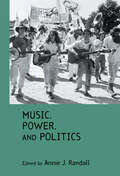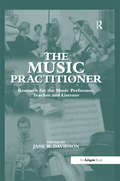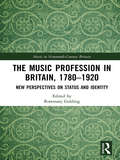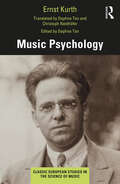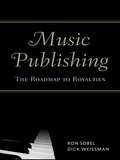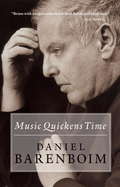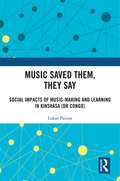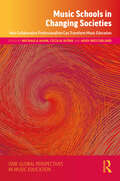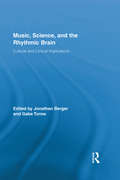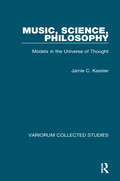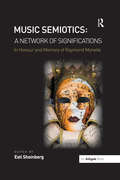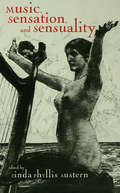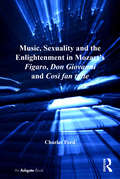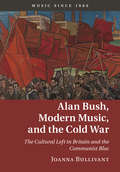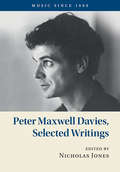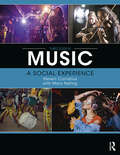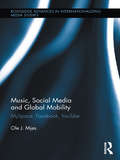- Table View
- List View
Music, Power, and Politics
by Annie J. RandallMusic, Power, and Politics presents sixteen different cultural perspectives on the concept of music as a site of socio-political struggle. Essays by scholars from around the world explore the means by which music's long-acknowledged potential to persuade, seduce, indoctrinate, rouse, incite, or even silence listeners, has been used to advance agendas of power and protest. The essays included examine: music used to convey political ideology in Nazi Germany, apartheid-era South Africa, and modern-day North Korea postcolonial musical efforts to reclaim ethnic heritage in Serbia and the Caribbean music as a means of establishing new cultural identities for recently empowered social groups in the UK and Brazil the subversion of racial stereotypes through popular music in the USA music as a tool of popular resistance to oppressive government policies in modern day Iran and the Bolivian Andes
The Music Practitioner: Research for the Music Performer, Teacher and Listener
by JaneW. DavidsonUseful work has been done in recent years in the areas of music psychology, philosophy and education, yet this is the first book to provide a wide assessment of what practical benefits this research can bring to the music practitioner. With 25 chapters by writers representing a broad range of perspectives, this volume is able to highlight many of the potential links between music research and practice. The chapters are divided into five main sections. Section one examines practitioners use of research to assist their practice and the ways in which they might train to become systematic researchers. Section two explores research centred on perception and cognition, while section three looks at how practitioners have explored their everyday work and what this reveals about the creative process. Section four focuses on how being a musician affects an individual‘s sense of self and the how others perceive him or her. The essays in section five outline the new types of data that creative researchers can provide for analysis and interpretation. The concluding chapter discusses that key question - what makes music affect us in the way it does? The research findings in each chapter provide useful sources of data and raise questions that are applicable across the spectrum of music-related disciplines. Moreover, the research methodologies applied to a specific question may have broader application for readers wishing to take on research themselves.
The Music Producer's Ultimate Guide to FL Studio 20: Create production-quality music with FL Studio
by Joshua Au-YeungLeverage the power of FL Studio 20 to create and compose production-quality songs and develop professional music production skillKey FeaturesLeverage the power of FL Studio to create your own production-level musicDevelop widely applicable music production skills and learn how to promote your musicUtilize cutting-edge tools to fuel your creative ideas and publish your songsBook DescriptionFL Studio is a cutting-edge software music production environment. It's an extremely powerful and easy to use tool for creating music. This book will give you everything you need to produce music with FL Studio at a professional level. You'll begin by exploring FL studio 20's vast array of tools and discover best practices, tips, and tricks for creating music. You'll learn how to set up your studio environment, create a beat, compose a melody and chord progression, mix sounds with effects, and export songs. You'll learn how to use tools such as the Piano roll, mixer console, audio envelopes, types of compression, equalizers, vocoders, vocal chops, and tools for increasing stereo width. The book introduces you to mixing best practices and how to master your songs. Along the way, you'll explore glitch effects and create your own instruments and custom designed effect chains. We'll also cover ZGameEditor Visualizer, a tool for creating reactive visuals for your songs. Finally, you'll learn how to register, sell, and promote your music. By the end of this FL Studio book, you'll be able to utilize cutting-edge tools to fuel your creative ideas, mix music effectively, and publish your songs.What you will learnGet up and running with FL Studio 20Record live instruments and vocals and process themCompose melodies and chord progressions on the Piano rollDiscover mixing techniques and apply effects to your tracksExplore best practices to produce music like a professionalPublish songs in online stores and promote your music effectivelyWho this book is forThis book is for music producers, composers, songwriters, DJs, and audio engineers interested in creating their own music, improving music production skills, mixing and mastering music, and selling songs online. To get started with this book, all you need is a computer and FL Studio.
The Music Profession in Britain, 1780-1920: New Perspectives on Status and Identity (Music in Nineteenth-Century Britain)
by Rosemary GoldingProfessionalisation was a key feature of the changing nature of work and society in the nineteenth century, with formal accreditation, registration and organisation becoming increasingly common. Trades and occupations sought protection and improved status via alignment with the professions: an attempt to impose order and standards amid rapid social change, urbanisation and technological development. The structures and expectations governing the music profession were no exception, and were central to changing perceptions of musicians and music itself during the long nineteenth century. The central themes of status and identity run throughout this book, charting ways in which the music profession engaged with its place in society. Contributors investigate the ways in which musicians viewed their own identities, public perceptions of the working musician, the statuses of different sectors of the profession and attempts to manipulate both status and identity. Ten chapters examine a range of sectors of the music profession, from publishers and performers to teachers and military musicians, and overall themes include class, gender and formal accreditation. The chapters demonstrate the wide range of sectors within the music profession, the different ways in which these took on status and identity, and the unique position of professional musicians both to adopt and to challenge social norms.
Music Psychology (Classic European Studies in the Science of Music)
by Ernst KurthThe first edition of Ernst Kurth’s Musikpsychologie appeared in 1931, and was regarded by contemporaneous psychologists as no less than the foundation for a new systematic approach to the perception and cognition of music. Time has hardly diminished Kurth’s standing as an original scholar with a distinctive point of view. Music theorists, both in Europe and North America, regard him as an important figure in the history of music theory. Daphne Tan and Christoph Neidhöfer’s first full translation provides English-speaking theorists the opportunity to delve deeper into his ideas. Indeed, Kurth’s concerns – listening habits and habituation, metaphorical language, the limits of memory, and the role of the body in music experience, to name a few – are shared by many in the field today, especially scholars who work at the intersections of music theory, psychology, linguistics, and related disciplines. And while Kurth’s approach lacks the scientific rigour of modern-day empirical musicology, Musikpsychologie nevertheless presents a source of testable hypotheses for those working in the area of music perception and cognition. This translation of Musikpsychologie also has the potential to inspire a new generation of composers, especially through the topics in the second section (energy, force, space, and matter) and, given the inherently interdisciplinary nature of this book and the number of philosophical and scientific sources Kurth incorporates, it will appeal to those interested in the history of science and particularly in the emergence of psychology as an academic discipline in the early 20th century.
Music Publishing: The Roadmap to Royalties
by Ron Sobel Dick WeissmanMusic Publishing covers the basics of how a composition is copyrighted, published, and promoted. Publishing in the music business goes far beyond the physical sheet--it includes live performance and mechanical (recording) rights, and income streams from licensing deals of various kinds. A single song can generate over thirty different royalty streams, and a writer must know how these royalties are calculated and who controls the flow of the money. Taking a practical approach, the authors -- one a successful music publisher and attorney, the other a songwriter and music business professor -- explain in simple terms the basic concept of copyright law as it pertains to compositions. Throughout, they give practical examples from "real world" situations that illuminate both potential pitfalls and possible upsides for the working composers.
Music Quickens Time
by Daniel BarenboimIn this eloquent book, Daniel Barenboim draws on his profound and uniquely influential engagement with music to argue for its central importance in our everyday lives. While we may sometimes think of personal, social and political issues as existing independently of each other, Barenboim shows how music teaches that this is impossible. Turning to his intense involvement with Palestine, he examines the transformative power of music in the world, from his own performances of Wagner in Israel and his foundation, with Edward Said, of the internationally acclaimed West-Eastern Divan Orchestra. Music Quickens Time reveals how the sheer power and eloquence of music offers us a way to explore and shed light on the way in which we live, and to illuminate and resolve some of the most intractable issues of our time.
Music Saved Them, They Say: Social Impacts of Music-Making and Learning in Kinshasa (DR Congo)
by Lukas PaironMusic Saved Them, They Say: Social Impacts of Music-Making and Learning in Kinshasa (DR Congo) explores the role music-making has played in community projects run for young people in the poverty-stricken and often violent surroundings of Kinshasa, the capital city of the Democratic Republic of the Congo. The musicians described here – former gang members and so-called "witch children" living on the streets – believe music was vital in (re)constructing their lives. Based on fieldwork carried out over the course of three-and-a-half years of research, the study synthesizes interviews, focus group sessions, and participant observation to contextualize this complicated cultural and social environment. Inspired by those who have been "saved by music", Music Saved Them, They Say seeks to understand how structured musical practice and education can influence the lives of young people in such difficult living conditions, in Kinshasa and beyond. "... a tribute to the persistence, engagement and courage of the people in these projects, who can be proud that their work is now exposed to a global audience, not just of researchers but also to practitioners around the world who could learn from and be inspired by these hitherto unknown projects." —John Sloboda, Research Professor, Guildhall School of Music & Drama
Music Schools in Changing Societies: How Collaborative Professionalism Can Transform Music Education (ISME Series in Music Education)
by Michaela Hahn, Cecilia Björk, and Heidi WesterlundMusic Schools in Changing Societies addresses the need to understand instrumental and vocal pedagogy beyond the individual sphere of teacher–student interactions and psychological phenomena, focusing instead on the wider sociocultural, spatial, and institutional contexts of music education. Viewing music education through the perspective of collaboration, the book focuses on the context of European music schools, which have developed a central role in publicly funded educational and cultural systems. The authors demonstrate that multilevel collaboration is a vital part of how music educators and the schools where they work can respond to wider societal concerns in ways that improve educational quality. Presenting examples of innovative practices and collaborative settings from twelve European countries, this book offers new and inspiring perspectives on how music schools can support the transformation towards collaborative professionalism in instrumental and vocal music education. With contributions from a wide range of researchers and professional educators, the book shows how a collaborative approach to music education can address major policy issues such as inclusion, democracy, and sustainability. Addressing current institutional and curricular challenges, Music Schools in Changing Societies presents a unique outlook on how music schools in contemporary societies can survive and thrive in times of change.
Music, Science, and the Rhythmic Brain: Cultural and Clinical Implications (Routledge Research in Music)
by Jonathan Berger Gabe TurowThis book studies the effects of repetitive musical rhythm on the brain and nervous system, and in doing so integrates diverse fields including ethnomusicology, psychology, neuroscience, anthropology, religious studies, music therapy, and human health. It presents aspects of musical rhythm and biological rhythms, and in particular rhythmic entrainment, in a way that considers cultural context alongside theoretical research and discussions of potential clinical and therapeutic implications. Considering the effects of drumming and other rhythmic music on mental and bodily functioning, the volume hypothesizes that rhythmic music can have a dramatic impact on mental states, sometimes catalyzing profound changes in arousal, mood, and emotional states via the stimulation of changes in physiological functions like the electrical activity in the brain. The experiments presented here make use of electroencephalography (EEG), galvanic skin response (GSR), and subjective measures to gain insight into how these mental states are evoked, what their relationship is to the music and context of the experience, and demonstrate that they are happening in a consistent and reproducible fashion, suggesting clinical applications. This comprehensive volume will appeal to scholars in cognition, ethnomusicology, and music perception who are interested in the therapeutic potential of music.
Music, Science, Philosophy: Models in the Universe of Thought
by Jamie C. KasslerThis book stresses the interrelatedness of knowledge by extricating models that cut across traditional disciplinary boundaries. For example, science can find models from the technology and semantic field of music, music can find its models from the technology and semantic field of science, and each domain may be guided by a philosophical or metaphysical principle - thus, the title of the book. But the book itself is structured as a mirror image of its title. Chapters 1-6 provide instances of the role of music in such domains as epistemology and logic, as well as in the early modern sciences of developmental biology, continuum mechanics, anatomy and physiological psychology, whereas Chapters 7-10 provide instances of what some other domains of knowledge have given back to the philosophy and theory of music.
Music Semiotics: In Honour and Memory of Raymond Monelle
by Esti SheinbergUnited in their indebtedness to the scholarship of Raymond Monelle, an international group of contributors, including leading authorities on music and culture, come together in this state of the art volume to investigate different ways in which music signifies. Music semiotics asks what music signifies as well as how the signification process takes place. Looking at the nature of musical texts and music's narrativity, a number of the essays in this collection delve into the relationship between music and philosophy, literature, poetry, folk traditions and the theatre, with opera a genre that particularly lends itself to this mode of investigation. Other contributions look at theories of musical markedness, metaphor and irony, using examples and specific musical texts to serve as case studies to validate their theoretical approaches. Musical works discussed include those by Haydn, Mozart, Beethoven, Schumann, Wagner, Stravinsky, Bart Xenakis, Kutavicius and John Adams, offering stimulating discussions of music that attest to its beauty as much as to its intellectual challenge. Taking Monelle's writing as a model, the contributions adhere to a method of logical argumentation presented in a civilized and respectful way, even - and particularly - when controversial issues are at stake, keeping in mind that contemplating the significance of music is a way to contemplate life itself.
Music, Sensation, and Sensuality (Critical and Cultural Musicology)
by Linda Phyllis AusternDivided into three sections, Linda Phyllis Austern collects eighteen, cross-disciplinary essays written by some of the most important names in the field to look at this stimulating topic. The first section focuses on the cultural and scientific ways in which music and the sense of hearing work directly on the mind and body. Part Two investigates how music works on the socially constructed, representational or sexualized body as a means of healing, beautifying and maintaining a balance between the mental and physical. Finally, the book explores the action of music as it is heard and sensed by wider social units, such as the body politic, mass communication, from print to sound recording, and broadcast technologies.
Music, Sexuality and the Enlightenment in Mozart's Figaro, Don Giovanni and Così fan tutte
by Charles FordMusic, Sexuality and the Enlightenment explains how Mozart's music for Le nozze di Figaro, Don Giovanni and Così fan tutte 'sounds' the intentions of Da Ponte's characters and their relationships with one another. Mozart, by way of the infinitely generative and beautiful logic of the sonata principle, did not merely interpret Da Ponte's characterizations but lent them temporal, musical forms. Charles Ford's analytic interpretation of these musical forms concerns processes and structures in detail and at medium- to long-term levels. He addresses the music of a wide range of arias and ensembles, and develops original ways to interpret the two largely overlooked operatic genres of secco recitative and finales. Moreover, Ford presents a new method by which to relate musical details directly to philosophical concepts, and thereby, the music of the operas to the inwardly contradictory thinking of the European Enlightenment. This involves close readings of late eighteenth-century understandings of 'man' and nature, self and other, morality and transgression, and gendered identities and sexuality, with particular reference to contemporary writers, especially Goethe, Kant, Laclos, Rousseau, Sade, Schiller, Sterne and Wollstonecraft. The concluding discussion of the implied futures of the operas argues that their divided sexualities, which are those of the Enlightenment as a whole, have come to form our own unquestioned assumptions about gender differences and sexuality. This, along with the elegant and eloquent precision of Mozart's music, is why Figaro, Giovanni and Così still maintain their vital immediacy for audiences today.
Music since 1900: The Cultural Left in Britain and the Communist Bloc (Music since 1900)
by Joanna BullivantThe first major study of Alan Bush, this book provides new perspectives on twentieth-century music and communism. British communist, composer of politicised works, and friend of Soviet musicians, Bush proved to be 'a lightning rod' in the national musical culture. His radical vision for British music prompted serious reflections on aesthetics and the rights of artists to private political opinions, as well as influencing the development of state-sponsored music making in East Germany. Rejecting previous characterisations of Bush as political and musical Other, Joanna Bullivant traces his aesthetic project from its origins in the 1920s to its collapse in the 1970s, incorporating discussion of modernism, political song, music theory, opera, and Bush's response to the Soviet music crisis of 1948. Drawing on a wealth of archival sources, including recently released documents from MI5, this book constructs new perspectives on the 'cultural Cold War' through the lens of the individual artist.
Music Since 1900: The Graph Music of Morton Feldman
by David ClineMorton Feldman is widely regarded as one of America's greatest composers. His music is famously idiosyncratic, but, in many cases, the way he presented it is also unusual because, in the 1950s and 1960s, he often composed in non-standard musical notations, including a groundbreaking variety on graph paper that facilitated deliberately imprecise specifications of pitch and, at times, other musical parameters. Feldman used this notation, intermittently, over seventeen years, producing numerous graph works that invite analysis as an evolving series. Taking this approach, David Cline marshals a wide range of source materials - many previously unpublished - in clarifying the ideology, organisation and generative history of these graphs and their formative role in the chronicle of post-war music. This assists in pinpointing connections with Feldman's compositions in other formats, works by other composers, notably John Cage, and contemporary currents in painting. Performance practice is examined through analysis of Feldman's non-notated preferences and David Tudor's celebrated interpretations.
Music Since 1900: Transformations of Musical Modernism
by Guldbrandsen, Erling E. and Johnson, Julian Erling E. Guldbrandsen Julian JohnsonProfound transformations in the composition, performance and reception of modernist music have taken place in recent decades. This collection brings fresh perspectives to bear upon key questions surrounding the forms that musical modernism takes today, how modern music is performed and heard, and its relationship to earlier music. In sixteen chapters, leading figures in the field and emerging scholars examine modernist music from the inside, in terms of changing practices of composition, musical materials and overarching aesthetic principles, and from the outside, in terms of the changing contextual frameworks in which musical modernism has taken place and been understood. Shaped by a 'rehearing' of modernist music, the picture that emerges redraws the map of musical modernism as a whole and presents a full-scale re-evaluation of what the modernist movement has all been about.
Music Since 1900: Performance Practice in the Music of Steve Reich
by Russell HartenbergerPerformance Practice in the Music of Steve Reich provides a performer's perspective on Steve Reich's compositions from his iconic minimalist work, Drumming, to his masterpiece, Music for 18 Musicians. It addresses performance issues encountered by the musicians in Reich's original ensemble and the techniques they developed to bring his compositions to life. Drawing comparisons with West African drumming and other non-Western music, the book highlights ideas that are helpful in the understanding and performance of rhythm in all pulse-based music. Through conversations and interviews with the author, Reich discusses his percussion background and his thoughts about rhythm in relation to the music of Ghana, Bali, India, and jazz. He explains how he used rhythm in his early compositions, the time feel he wants in his music, the kind of performer who seems to be drawn to his music, and the way perceptual and metrical ambiguity create interest in repetitive music.
Music Since 1900: Peter Maxwell Davies, Selected Writings (Music since 1900)
by Nicholas JonesThis book brings together an extensive and varied collection of Sir Peter Maxwell Davies's written and spoken-word items for the first time. Spanning the composer's entire career, this compendium offers a balanced selection of Davies's articles and essays, speeches and lectures, interviews, radio broadcasts, programme notes, tributes and letters to newspapers. A number of items are published for the first time, including a new article from Davies himself (commissioned specially for this book), and several BBC radio broadcast interviews and talks from the 1960s. The structure of the book is chronological and divided into three parts, allowing readers to trace the development of Davies's thought and work over time, and to place each item in its biographical and historical context. The introduction and notes by Nicholas Jones place the writings in context, making this volume invaluable for those interested in the music and wider culture of post-war Britain.
Music Since 1900: Luigi Nono
by Carola Nielinger-VakilThe anti-fascist cantata Il canto sospeso, the string quartet Fragmente - Stille, an Diotima and the 'Tragedy of Listening' Prometeo cemented Luigi Nono's place in music history. In this study, Carola Nielinger-Vakil examines these major works in the context of Nono's amalgamation of avant-garde composition with Communist political engagement. Part I discusses Il canto sospeso in the context of all of Nono's anti-fascist pieces, from the unfinished Fučik project (1951) to Ricorda cosa ti hanno fatto in Auschwitz (1966). Nielinger-Vakil explores Nono's position at the Darmstadt Music Courses, the evolution of his compositional technique, his penchant for music theatre and his use of spatial and electronic techniques to set the composer and his works against the diverging circumstances in Italy and Germany after 1945. Part II further examines these concerns and shows how they live on in Nono's work after 1975, culminating in a thorough analysis of Prometeo.
Music Since 1900: British Musical Modernism
by Philip RupprechtBritish Musical Modernism explores the works of eleven key composers to reveal the rapid shifts of expression and technique that transformed British art music in the post-war period. Responding to radical avant-garde developments in post-war Europe, the Manchester Group composers - Alexander Goehr, Peter Maxwell Davies, and Harrison Birtwistle - and their contemporaries assimilated the serial-structuralist preoccupations of mid-century internationalism to an art grounded in resurgent local traditions. In close readings of some thirty-five scores, Philip Rupprecht traces a modernism suffused with the formal elegance of the 1950s, the exuberant theatricality of the 1960s, and - in the works of David Bedford and Tim Souster - the pop, minimalist, and live-electronic directions of the early 1970s. Setting music-analytic insights against a broader social-historical backdrop, Rupprecht traces a British musical modernism that was at once a collective artistic endeavor, and a sounding myth of national identity.
Music Since 1900: Musical Witness and Holocaust Representation
by Amy Lynn WlodarskiThis is the first musicological study entirely devoted to a comprehensive analysis of musical Holocaust representations in the western art music tradition. Through a series of chronological case studies grounded in primary source analysis, Amy Lynn Wlodarski analyses the compositional processes and conceptual frameworks that provide key pieces with their unique representational structures and critical receptions. The study examines works composed in a variety of musical languages – from Arnold Schoenberg's dodecaphonic A Survivor from Warsaw to Steve Reich's minimalist Different Trains – and situates them within interdisciplinary discussions about the aesthetics and ethics of artistic witness. At the heart of this book are important questions about how music interacts with language and history; memory and trauma; politics and mourning. Wlodarski's detailed musical and cultural analyses provide new models for the assessment of the genre, illustrating the benefits and consequences of musical Holocaust representation in the second half of the twentieth century.
Music Sketches
by Friedemann SallisThe term 'music sketch' relates to the vast variety of documents that are used by composers to work out a musical technique or idea and to prepare their work for performance or publication. These documents can often provide crucial insights into authorship, biography, editorial practice and musical analysis. This Introduction provides students and scholars with the knowledge and skills they need to embark on research projects involving the study of composers' working documents. Presenting examples of the compositional process over a 400-year period, it includes a selection of detailed case studies on how sketches were created and the techniques that were used, such as transcription and the sorting of loose leaves. Numerous illustrations of manuscripts and autographs, many of which have never been published before, show how these vital documents can be used to better understand the compositional processes of the seventeenth and eighteenth centuries.
Music: A Social Experience
by Steven Cornelius Mary NatvigBy taking a thematic approach to the study of music appreciation, Music: A Social Experience, Third Edition demonstrates how music reflects and deepens both individual and cultural understandings. Musical examples are presented within universally experienced social frameworks (ethnicity, gender, spirituality, love, and more) to help students understand how music reflects and advances human experience. Students engage with multiple genres (Western art music, popular music, and world music) through lively narratives and innovative activities. A companion website features streaming audio and instructors' resources. The third edition includes: A chapter on Black American music A revised and developed chapter on gender and sexuality A dozen additional Listening Guides, with an emphasis on contemporary popular music Over 100 new full-color images Updated teacher and student resources on the book’s companion website Expanded content throughout, highlighting the social, cultural, and technological changes since publication of the previous edition The culmination of thirty years of experimentation in the music appreciation classroom, this third edition of Music: A Social Experience continues to empower lifelong musical learning by engaging students and readers on their own terms.
Music, Social Media and Global Mobility: MySpace, Facebook, YouTube (Routledge Advances in Internationalizing Media Studies)
by Ole J. MjosThis book is about the relationship between media, communication and globalization, explored through the unique empirical study of electronic music practitioners’ use of the global social media: MySpace, Facebook, YouTube and Twitter. To understand the significance of the emerging nexus between social media and music in a global context, the book explores various aspects of production, distribution and consumption among electronic music practitioners as they engage with global social media, as well as a historical, political and economic exposition of the rise of this global social media environment. Drawing on interview-based research with electronic music artists, DJs, producers and managers, together with the historical portrayal of the emergence of global social media this pioneering study aims to capture a development taking place in music culture within the wider transformations of the media and communications landscape; from analogue to digital, from national to global, and from a largely passive to more active media use. In doing so, it explores the emergence of a media and communications ecology with increased mobility, velocity and uncertainty. The numerous competing, and rapidly growing and fading social media exemplify the vitality and volatility of the transforming global media, communication and cultural landscape. This study suggests that the music practitioner’s relationship with MySpace, Facebook, YouTube and Twitter and the key characteristics of these global social media, alter aspects of our practical and theoretical understandings of the process of media globalization. The book deploys an interdisciplinary approach to media globalization that takes into account and articulates this relationship, and reflects the enduring power equations and wider continuities and changes within the global media and communications sphere.
